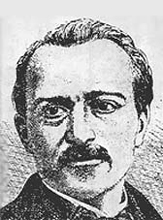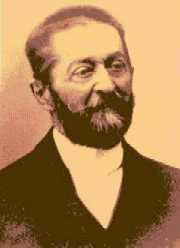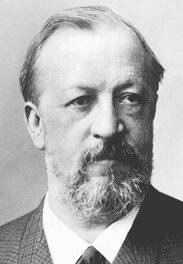<Back to Index>
- Engineer Jean Joseph Étienne Lenoir, 1822
- Engineer Alphonse Eugène Beau de Rochas, 1815
- Inventor Nikolaus August Otto, 1832
PAGE SPONSOR

Jean Joseph Étienne Lenoir (12 January 1822 - 4 August 1900) was a Belgian engineer who developed the internal combustion engine in 1859. Prior designs for such engines were patented as early as 1807, but none were commercially successful. Lenoir's engine was commercialized in sufficient quantities to be considered a success, a first for the internal combustion engine.
He was born in Mussy - la - Ville (then in Luxembourg, part of Belgium from 1839). By the early 1850s he had emigrated to France, taking up residence in Paris, where he developed an interest in electroplating. His interest in the subject led him to make electrical inventions including an improved electric telegraph.
By 1859, Lenoir's experimentation without electricity led him to develop the first single cylinder two - stroke engine which burnt a mixture of coal gas and air ignited by a "jumping spark" ignition system by Ruhmkorff coil, and which he patented in 1860. The engine differed from more modern two - stroke engines in that the charge was not compressed before ignition (a system invented in 1801 by Lebon D'Humberstein, which was quiet but inefficient), with a power stroke at each end of the cylinder. In 1863 the Hippomobile with a hydrogen gas fueled one cylinder internal combustion engine made a test drive from Paris to Joinville - le - Pont: top speed about 9 km in ~3 hours.
Lenoir was an engineer at petiene et Cie, who formed companies (Société des Moteurs Lenoir + more) in Paris in 1859, with a capitalization of two million francs and a factory in the Rue de la Roquette,
to develop the engine, and a three - wheeled carriage constructed using
it. Although it ran reasonably well, the engine was fuel inefficient,
extremely noisy, tended to overheat and, if sufficient cooling water was
not applied, seize up. Nevertheless, Scientific American advised in September 1860 the Parisian newspaper Cosmos had pronounced the steam age over, and by 1865, 143 had been sold in Paris alone, and production by Reading Gas Works for Lenoir Gas Engines in London had begun.
In 1863 Lenoir demonstrated a second three - wheeled carriage, little more than a wagon body set atop a tricycle platform. It was powered by a 2543 cc (155 in3; 180×100 mm, 7.1×3.9in) 1.5 hp "liquid hydrocarbon" (petroleum) engine with a primitive carburettor which was patented in 1886. It successfully covered the 11 km (7 mi) from Paris to Joinville - le - Pont and back in about ninety minutes each way, an average speed less than that of a walking man (though doubtless there were breakdowns). This succeeded in attracting the attention of tsar Alexander II, and one was sent to Russia, where it vanished. (Lenoir himself was not pleased, however; in 1863, he sold his patents to Compagnie Parisienne du Gaz and turned to motorboats, instead, building a naptha - fueled four - cycle in 1888.)
Most applications of the Lenoir engine were as a stationary power
plant powering printing presses, water pumps, and machine tools. They
"proved to be rough and noisy after prolonged use", however. Other engineers, especially Nikolaus Otto, began making improvements in internal combustion technology which soon
rendered the Lenoir design obsolete. Less than 500 Lenoir engines of
between 6 and 20 hp were built, including some under license in Germany.
Granted French citizenship 1870 for assistance during the Franco - Prussian War, and awarded the Légion d'honneur in 1881 (not for the engine, but for developments in telegraphy), Lenoir's later years were impoverished despite his engine's success.
Lenoir died in at La Varenne - Sainte - Hilaire on August 4, 1900.

Alphonse Eugène Beau de Rochas (9 April 1815, Digne - les - Bains, Alpes - de - Haute - Provence - 27 March 1893) was a French engineer who originated the principle of the four - stroke internal combustion engine. His achievement lay partly in his emphasizing the previously unappreciated importance of compressing the fuel – air mixture before ignition. He published his results in 1861, a year after Christian Reithmann was granted a patent in Germany and 16 years before Nicolaus Otto obtained his patent.

Nikolaus August Otto (14 June 1832, Holzhausen an der Haide, Nassau - 26 January 1891, Cologne) was the German inventor of the first internal combustion engine to efficiently burn fuel directly in a piston chamber. Although other internal combustion engines had been invented (e.g., by Étienne Lenoir) these were not based on four separate strokes. Though the concept of four strokes had been theorized in 1861 by Alphonse Beau de Rochas, Otto was the first to make it practical.
Otto was the son of a farmer: his father also ran the local post office. He served an apprenticeship in commerce and following his apprenticeship worked as a business man in Frankfurt am Main and in Cologne. After relocating to Cologne he quit his office job in order to construct small gas engines, starting out by seeking to improve on the existing design of Étienne Lenoir. Otto met another engineer Eugen Langen in 1864. The technically trained Langen recognized the potential of Otto's development, and one month after the meeting, founded the first engine factory in the world, NA Otto & Cie. At the 1867 Paris World Exhibition their improved engine was awarded the Grand Prize.
The Otto & Langen engine was a free piston atmospheric engine (the explosion of gas was used to create a vacuum and the power came from atmospheric pressure returning the piston). It consumed less than half the gas of the Lenoir and Hugon engines and so was a commercial success. The principle of operation was described by the Italian inventors Eugenio Barsanti and Felice Matteucci in their British Patent no 1625 of 1857, though they never produced a marketable example.
Otto later turned his attention to the 4 stroke cycle (as described in a pamphlet by Alphonse Beau de Rochas in 1862). It is this engine (the Otto Silent Engine), and not the Otto & Langen engine, to which the Otto cycle refers. This was the first commercially successful engine to use in-cylinder compression (as patented by William Barnett in 1838).
Otto married Anna Gossi and the couple produced seven recorded children. His son Gustav Otto grew up to become an aircraft builder.
The Otto engine was designed as a stationary engine and in the action of the engine, the stroke is an upward or downward movement of a piston in a cylinder. Used later in an adapted form as an automobile engine, four strokes are involved: (1) downward intake stroke — coal - gas and air enter the piston chamber, (2) upward compression stroke — the piston compresses the mixture, (3) downward power stroke — ignites the fuel mixture by electric spark, and (4) upward exhaust stroke — releases exhaust gas from the piston chamber. Otto only sold his engine as a stationary motor.
According to recent historical studies, the Italian inventors Eugenio Barsanti and Felice Matteucci patented a first working efficient version of an internal combustion engine in 1854 in London (pt. Num. 1072). It is claimed that the Otto engine is in many parts at least inspired from this precedent invention, but, as yet there is no documentation of knowledge about the Italian engine by Otto. The concept of the four - stroke engine was also patented (October 26, 1860) by the Austrian Christian Reithmann for one year and by the French Alphonse Beau de Rochas (January 16, 1862).